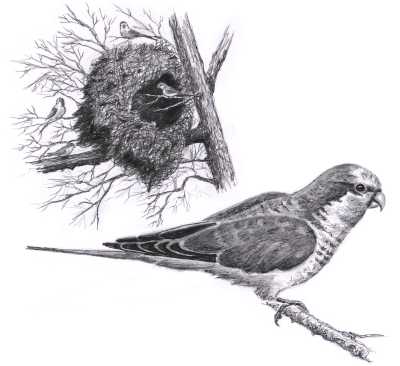
Dear Bird Folks:
I read in last week’s Wildlife Sightings that a few monk parakeets have been seen on the Upper Cape. My friend from Connecticut told me that monk parakeets are a big problem in his area. He claims that they are noisy and destructive. Are they bad birds and are they headed this way?
Matt, Brewster
First Matt,
Why are you listening to someone from Connecticut? I wouldn’t trust anyone from the “Nutmeg State.” I’ve been to Connecticut thousands of times and never once have I seen a nutmeg tree. Massachusetts is the “Bay State” and we clearly have lots of bays, but where are the nutmeg trees in Connecticut? There is something fishy going on there.
Now on to your question. Monk parakeets are noisy, mostly green, foot-long birds, with a gray breast and forehead. Their gray front, for some reason, reminded some wackos of monks, so hence the name. In the late 60’s, tens of thousands of monk parakeets were captured in their native homeland of central South America and brought into our contry for the entertainment of people who enjoy keeping things in cages. Sometime around 1970, a container of these birds was dropped at New York’s Kennedy Airport and many birds escaped into the wild. Also, some of the caged bird people who could no longer stand the sounds of screaming parrots, “accidentally” left the doors open on their birds’ cages, allowing more birds to be out on their own.
In a rare show of solidarity, both environmentalists and farmers were upset at the thought of these parrots multiplying and chowing their way across the North American continent. At first, it appeared that their fears were well founded as monk parakeet colonies started to pop up around the country.
Monk parakeets build massive, bulky stick nests that sometimes hold hundreds of birds. They not only use these huge nests to lay eggs in, but the birds actually live in them year-round, like city folks live in a high rise. The nests will protect the birds from almost any kind of weather. So unlike most parrots, these guys can survive long periods of snow, cold and ice. One famous colony of parrots is found in Chicago, where even on the nice days the weather is bad.
We now have all the makings of major environmental trouble. Here is an introduced species that loves to eat, loves to breed and can handle even the worst weather. (No, I’m not talking about snowboarders.) Fortunately, for the most part, these birds live and die in the same nest and don’t move around very much. Birds that don’t move aren’t a serious threat to expand their range. After 30 years we only have a few random monk parakeet colonies scattered around the country. The big massive explosion of parrots has yet to happen.
Twenty years ago I had a monk parakeet at my feeder (they love sunflower seeds) and there are occasional reports of them being seen around the Cape. It is hard to tell if monk parakeets will ever set up a colony and move here. So what if they do, everyone else is.
Tell your friend that he shouldn’t hate the parrots, Matt, his anger should be pointed to the boneheads who dragged the birds into this country in the first place.
I’m sure the squawking and loud chatter of a hundred parrots could get on your nerves. But that is only a problem for the lucky few who live near a nest, which there aren’t that many of. At this point, the wrongly introduced monk parakeets have not become a major problem. They have not driven out native birds and they have not done any serious agricultural damage. The only agricultural damage that they have done was in Connecticut, where they have apparently wiped out every nutmeg tree in the entire state.